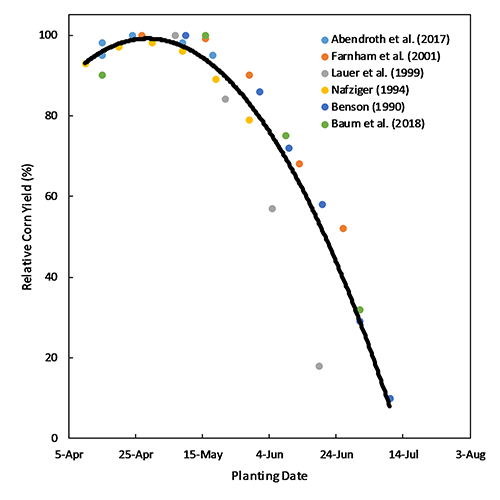ILSOYADVISOR POST
Corn vs. Soybeans: Which Benefits From Early Planting The Most
Most growers have been pushing the planting envelope earlier and earlier, of course weather permitting. However which crop, corn or soybeans, benefits more from early planting?
The diehard corn growers out there will probably vote that corn yields benefit more from early planting because the yield penalty for late planting can be greater. However, those who study soybean planting date and yield trends recognize that soybeans benefit more from early planting by increasing yield 5 to 10% over the traditional May planting date.
History: For many years growers planted corn first, usually starting the last week in April when soil temperatures were consistently at 50° F and increasing. When corn was planted and it was May, soybeans were planted when soil temperatures were above 55° F. How that has changed today! Corn and soybeans are both being planted in April—soil conditions permitting—with soil temperatures at 45 to 48° F and rising. Today varieties with better seedling vigor and cold tolerance, plus the use of seed treatment along with growers’ planting skills, enable the early planting of both crops.
Corn: The University of Nebraska assessed the effect

of planting date on corn yield. Click here to read the findings. They included data from Nebraska, Kansas, Iowa, Illinois, Wisconsin and Indiana (Figure 1). The authors concluded “Our general conclusion was that there is a “planting window” within which yields are often very similar and after which yields decline rapidly. That window seems to begin closing after mid-May.”
Emerson Nafziger with the University of Illinois participated in this study. “Nafziger planted corn at six locations for three years with four planting dates ranging from early April through early June. Yield losses were less than 1 bushel per acre per day until at least 20 days after the optimum planting date. With optimum planting dates of April 11-20 for his central and northern Illinois locations, potential yields by May 10 were within 4%-5% of the optimum yield. Southern Illinois yields were more affected by later planting.” Highest yields came from the earliest planting date through mid-May planting date.

in Illinois.
Soybeans: Nafziger conducted soybean planting date trials across Illinois. Click here to review his results. His trials included four dates with target ranges of April 15-20, May 5-10, May 20-25 and June 5-10. Thirty trials were conducted between 2010 and 2018 at Urbana, Perry, DeKalb and Monmouth. He also had two sites in Southern Illinois, but wet springs often interrupted being able to plant in a timely manner or get a good stand.
His data (Figure 2) indicated that there is little risk of yield loss planting too early. The data also showed that where was no significant real yield penalty from planting in mid to late April or the first week of May. But after May 10, yield begin to drop off, just as with corn.
My rule of thumb is that soybeans yields begin to drop off ½ bushel per day after May 10 and 1 bushel per day after June 1.
Which crop benefits more? Presently, the data shows that both crops respond similarly to planting in the same window, April 10 to May 10, with relative yields being similar across that timeframe. However, after May 10 yields of both crops begin to decline through May and especially into June.
Today everyone recognizes that planting soybeans early is critical to maximizing yield potential. This has been reported frequently through both University and industry studies in addition to grower data. However, many of us ‘argue’ that early planting significantly benefits soybean yields because the earlier soybeans emerge, the more nodes (and branches) they add to the plant and the greater the pod set. While with corn, planting early doesn’t increase yield potential but it does allow growers time to plant all their acres within the ideal window between April 10 and May 10, realizing that there will be days when it is too wet to plant and planters sit idle.

between corn and soybeans.
In 2017 Nafziger reported that yield of both crops responded similarly to planting date (Figure 3). He showed near-maximum yields when planted in mid-April to early May, and yields dropped to 95, 91, and 86% as planting was delayed to May 10, May 20 and May 30, respectively. Click here to read the findings.
When soybeans are planted early plants reach V1 earlier, resulting in earlier flowering date (R1) and a longer growing season, increasing the length of the seed-fill period. When plants reach V1 sooner, they accrue more nodes resulting in more potential pods and seeds per acre. Each additional 3.7 days added to the growing season by planting earlier adds an additional node. Nodes continue to accrue until R5. Click here to read more about the benefits to soybeans of early planting.





Comments
Add new comment